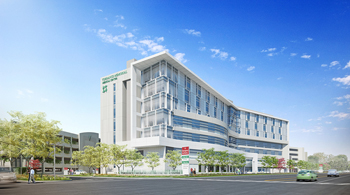$450 Million Torrance Memorial Tower to Replace Original
 TORRANCE, Calif. — The new $450 million Torrance Memorial Medical Center Replacement Tower is currently being constructed at the existing Torrance Memorial Medical Center site, and it will replace the hospital’s original one, built in 1971.
TORRANCE, Calif. — The new $450 million Torrance Memorial Medical Center Replacement Tower is currently being constructed at the existing Torrance Memorial Medical Center site, and it will replace the hospital’s original one, built in 1971.
“By building the new main tower, Torrance Memorial Medical Center will comply with OSHPD’s Senate Bill 1953. In addition, we will be able to increase bed capacity to address our community’s growing needs as our population ages,” said Connie Senner, director of construction for the medical center.
St. Louis-based McCarthy Building Companies is the general contractor for the project, while HMC Architects, headquartered in Santa Clara, Calif., is the architect.
Serving as the new front door of the medical center, the new 398,350-square-foot patient tower will consist of 256 private rooms and 18 surgical and interventional treatment rooms. A major focus of the tower is its patient-focused design, featuring family-friendly lounges, an outdoor healing garden and all-private patient rooms, with accommodations for family to power personal devices and stay overnight.
Also included in the project is a basement that will house a central utility plant and a tunnel connecting the existing hospital to the new facility. Twelve elevator systems and two exit stairs will be installed, and a 2,770-square-foot Emergency Generator building, with underground fuel oil storage tanks, will be constructed.
To prepare for the new tower, McCarthy had to reroute underground existing utilities and create an alternate entrance to the existing medical center for patients to use during construction.
Early site preparations for the facility began in January 2010, with construction on the tower starting in March 2011. The project is slated for completion in fall 2014, with the opening of the tower in 2015. The teamwork between everyone involved on the project has helped in keeping construction on schedule.
HMC, in collaboration with McCarthy and the sub-trades, used a design-assist delivery method to reduce or eliminate impacts to the schedule and potential construction delays, according to Chuck Eyberg, AIA, LEED AP BD+C, principal architect for HMC.
“From a construction cost standpoint, early trade involvement allows for optimizing the design solution as a result of the design engineer working directly with the sub-trade who will build the system,” Eyberg said. “With the collaborative effort occurring prior to the construction of the systems, the potential for misinterpretation, inconsistent direction and lack of information is reduced or eliminated. This leads to a more precise bidding environment and significantly reduces costly change orders during the construction phase.”
While design-assist was used to deliver the MEP (mechanical, electrical and plumping) systems, structural steel and framing, design-build will be used for the exterior skin, elevators and fire protection system.
“This project is a good example of how a collaborative delivery that involves the contractor and select subcontractors working in unison with the owner and their design team can result in a project delivery that will be more efficient for all parties when compared to the traditional design-bid-build method,” said Erik Chessmore, project director for McCarthy. “All of the stakeholders have been aligned with Torrance Memorial Medical Center project goals, budget, scope and schedule. This alignment combined with technology has made this project very successful on all fronts.”
Not only did the project require a collaborative effort from the construction staff, the project also benefitted from the hospital team’s involvement in the day-to-day logistical planning efforts, and Chessmore cited the steel erection as an example of this.
“The south elevation of our project shares a fence-line with the existing Emergency Department entrance. Though our hoists were kept within the construction perimeter, our team understood the importance of public perception,” Chessmore said. “The result was a coordinated effort that involved timing all steel picks with ED operations, providing personnel on the ground to notify and direct public traffic, and using a multimedia approach to keep the facility and staff informed. This level of synchronization between construction and the hospital is what we’ve achieved and expect on the many other interfaces we have with the existing facility.”
Because the hospital team was also open-minded, McCarthy was able to use the latest techniques and technologies to create an even higher level of efficiency. Paperless RFI and Submittal tracking, electronic construction documents, 4D scheduling 3D BIM and positioning technology have all contributed to enhancing project delivery, according to Chessmore.
